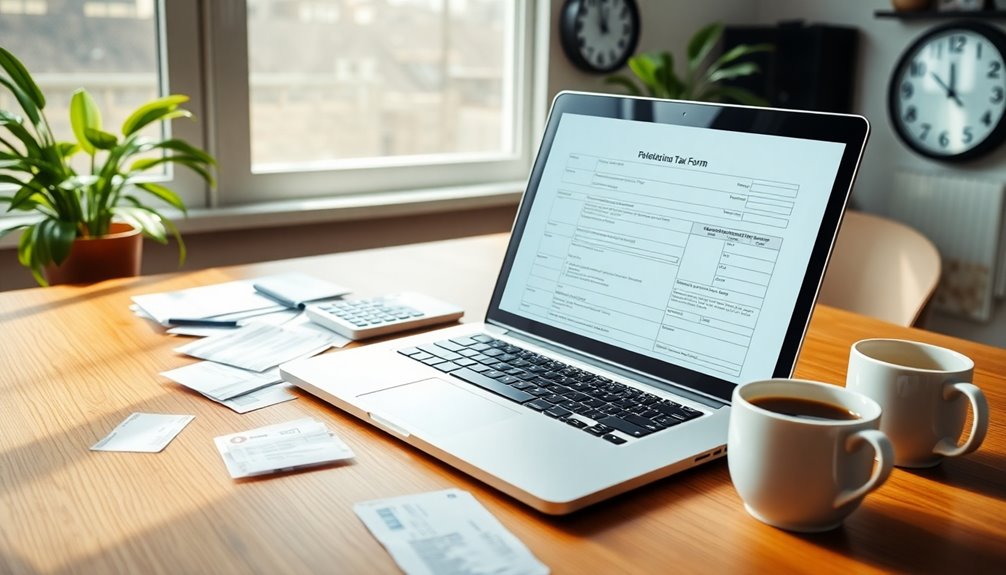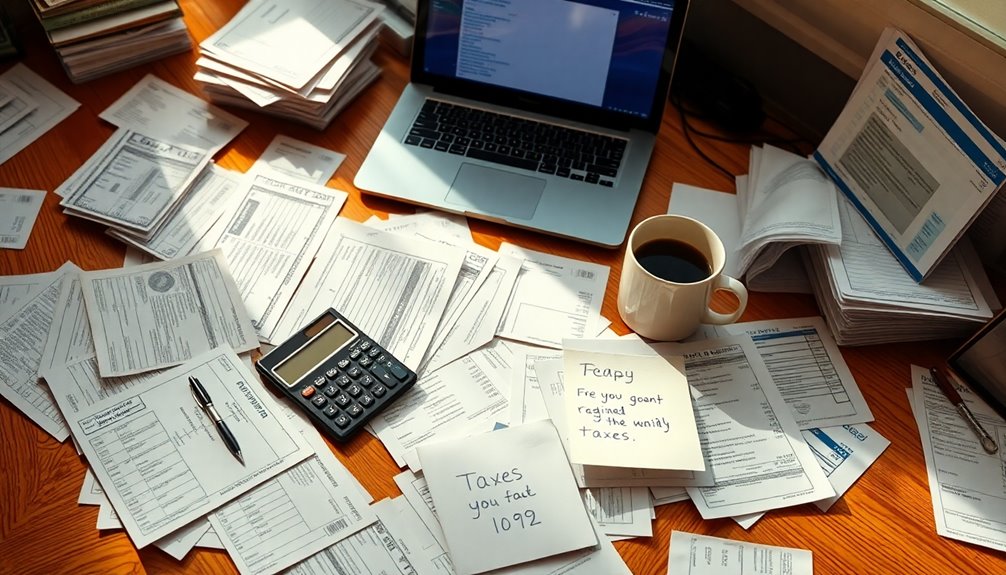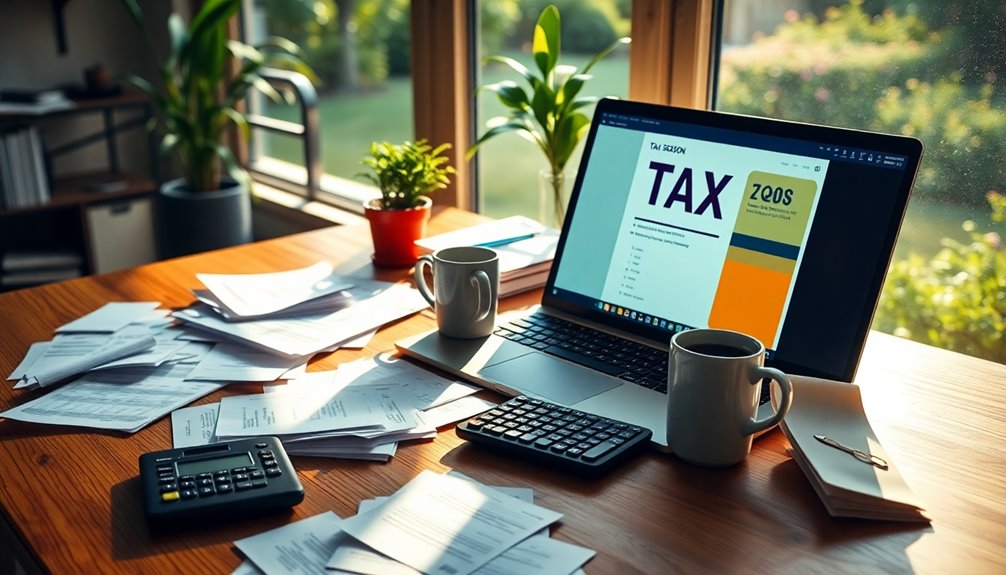You can handle your taxes without a W-2 by reporting your self-employment income accurately. Use Schedule C (Form 1040) to list your income and expenses, and remember to file Form 1040 to report your total income. If you earned over $600 from a company, you should receive a 1099-NEC form. If it's missing, use Form 4852 with estimated wages and taxes. Don't forget about deductible expenses and keep organized records to support your claims. Calculating your self-employment tax properly is crucial too. Stick around to discover tips for maximizing your deductions and common pitfalls to avoid.
Key Takeaways
- Use Form 1040 to report all income, including self-employment earnings, even without a W-2.
- Attach Form 4852 to substitute for a missing W-2, estimating wages and taxes.
- Gather year-end pay stubs to approximate total wages and withholdings if W-2 is unavailable.
- Contact your employer for a missing W-2 by February 1, or call the IRS for further assistance.
- Maintain organized records of income and expenses to simplify tax preparation and maximize deductions.
Understanding Self-Employment Status

Self-employment offers a unique opportunity for individuals to earn income on their own terms. When you're self-employed, you're not working for someone else; instead, you're generating income through your skills and services. This can involve various occupations, such as skilled trades, writing, freelancing, or providing professional services.
There are different types of self-employment, including independent contractors, sole proprietors, and partnerships. It's important to note that self-employment is distinct from owning a business. As a self-employed individual, you typically operate your business and may even hire a few employees to help you manage the workload. Additionally, self-employed individuals face unique challenges, such as greater income variability and employment risks. AI online jobs can also serve as a flexible option for self-employed individuals looking to diversify their income streams.
Understanding your self-employment status is crucial for navigating your financial responsibilities. You need to keep track of your income and expenses and ensure you're compliant with tax regulations.
If your net earnings are $400 or more, you're required to file a tax return and pay self-employment tax. This tax encompasses Social Security and Medicare contributions, totaling 15.3% of your net earnings.
Reporting Your Self-Employment Income

When you're self-employed, accurately reporting your income is vital for meeting tax obligations. To report your income, you'll need to use Schedule C (Form 1040). This form helps you detail all your business income and expenses, allowing you to determine your net profit or loss. Make sure to include every relevant dollar because Line 31 of Schedule C will show your net profit or loss, which is crucial for your tax calculations. Additionally, understanding how capital gains taxes apply to your earnings can affect your overall tax strategy.
If you've received a 1099-NEC form from companies that paid you over $600, use this document to report your earnings accurately. Compare the 1099-NEC with your personal records to catch any discrepancies before filing. Remember, you can also receive a 1099-MISC for other income types like rental payments or royalties.
Lastly, don't forget to file Form 1040 to report all your income, including your self-employment earnings. Include your basic information and make sure to list all income sources. It's also important to understand that self-employment tax covers Social Security and Medicare obligations, requiring you to pay both employee and employer portions.
Keep track of any related deductions you can claim, such as materials and travel expenses. Completing these forms thoroughly will help you stay compliant and avoid unnecessary penalties.
Calculating Self-Employment Tax

As you prepare your taxes, calculating your self-employment tax is crucial to ensure compliance and avoid penalties. Start by determining your net earnings, which you can find by subtracting your business expenses from your gross self-employment income, typically reported on Schedule C.
Remember, only self-employment income exceeding $400 is subject to self-employment tax, so keep track of your deductions to lower that amount. Additionally, individuals with net earnings of $400 or more from self-employment must pay this tax.
Next, calculate the taxable amount by multiplying your net earnings by 92.35%. This percentage reflects the portion of your earnings that are taxed, similar to the way employees share Social Security and Medicare taxes.
For the 2024 tax year, the Social Security tax rate is 12.4%, applicable only to the first $168,600 of your net earnings. The Medicare tax rate is 2.9%, with no income limit, plus an additional 0.9% surtax if your earnings exceed $200,000 as a single filer.
Finally, multiply the taxable amount by the respective rates for Social Security and Medicare. Add these two components together to find your total self-employment tax, and remember, you can deduct 50% of this tax on your income tax return.
Required Tax Forms and Schedules

To successfully file your taxes without a W-2, you'll need to gather specific forms and schedules that accurately reflect your income and deductions. The most important form is Form 1040, which you'll use to report your total income, deductions, and tax credits.
If you're missing a W-2, Form 4852 serves as a substitute, reporting your wages and any taxes withheld. It is important to note that using Form 4852 requires you to estimate your total wages and withholding from your final pay stub.
If you're self-employed, you'll need to fill out Schedule C (Form 1040) to report your business income and expenses, helping you calculate your net profit or loss.
Additionally, Schedule SE (Form 1040) is necessary for calculating self-employment tax, even though it doesn't directly relate to missing W-2s.
If you've received income through independent contracting, be sure to include any Form 1099 that applies.
Don't forget that state and local tax forms may also be required to report any withheld taxes.
Finally, keep in mind that you may need to provide verification documents, such as pay stubs or bank statements, to substantiate your income and tax withheld.
Supporting Documentation Needed

Gathering supporting documentation is vital for filing your taxes accurately without a W-2. If you haven't received your W-2 by January 31, reach out to your employer to request it.
In the meantime, use your last pay stub to estimate your total wages and withholdings, noting key details like social security wages and Medicare wages. It's essential to verify all taxes withheld throughout the year.
If you're still missing your W-2, call the IRS helpline at 1-800-829-1040 for assistance. Be ready to provide personal information and employer details; the IRS may contact your employer directly.
If you live abroad, use the American Abroad helpline at 1-267-941-1000.
Consider alternative documentation like a wage and income transcript from the IRS, although it may not be available until mid-summer. Some states require year-end pay stubs showing state withholding, so keep those handy.
Don't forget to maintain records of all income sources, receipts for charitable donations, and any work-related expenses. Keeping your tax-related paperwork organized will ensure you're prepared come tax season.
Quarterly Estimated Tax Payments

Understanding your tax obligations is crucial, especially when you need to make quarterly estimated tax payments. These payments are typically due on specific dates throughout the year.
For the first quarter (January 1 to March 31), the due date is April 15. The second quarter (April 1 to May 31) is due on June 15, or June 17 if that day falls on a weekend or holiday. The third quarter (June 1 to August 31) is due on September 15, or September 16 under the same conditions. Finally, the fourth quarter (September 1 to December 31) is due on January 15 of the next year.
To calculate your payments, estimate your adjusted gross income, taxable income, and applicable deductions. Use Form 1040-ES Estimated Tax Worksheet for accuracy. Remember that self-employment tax applies to individuals with over $400 in profit, impacting your overall tax calculations.
Add your income and self-employment taxes, then divide by four. You can make payments via the Electronic Federal Tax Payment System (EFTPS), online, by phone, or by mail with the appropriate voucher.
Be mindful of potential penalties for underpayment. If you file your annual return and pay in full by January 31, you can avoid penalties related to the fourth quarter.
Deductible Expenses for Self-Employment

When you're self-employed, knowing which expenses you can deduct can significantly reduce your taxable income. Start with your home office deductions. You can deduct a portion of your mortgage or rent based on the space you use for business. Don't forget property taxes, utilities, and repair costs related to your home office, too. You can choose between the simplified method or actual expenses for these deductions.
Next, consider your business operating expenses. Office supplies like paper and pens, as well as professional supplies specific to your field, are deductible. Also, insurance, internet, and telephone costs related to your business can help lower your tax bill. Software and equipment purchases can be deducted or depreciated over time.
Travel and meal expenses are also deductible. You can claim costs for flights, hotels, and transportation while traveling for business. Remember, you can deduct 50% of business meal costs, provided they're reasonable. Additionally, consider that ordinary and necessary expenses must be met for any deductions you claim.
Lastly, keep track of startup costs, client gifts, and website expenses, as these can also contribute to your deductions. Staying organized will help you maximize your eligible deductions come tax time.
Common Mistakes to Avoid

Filing your taxes can feel overwhelming, but avoiding common mistakes can make the process smoother. One major issue is math errors, which can delay processing and lead to incorrect refunds or additional tax owed. Use tax preparation software to automate calculations and always double-check complex figures. Pay special attention to negative numbers and ensure you're using the correct signs. Additionally, the IRS identified nearly 2.5 million math errors in 2017 tax returns, highlighting the importance of accuracy.
Another common pitfall is entering inaccurate or missing information. Make sure names are spelled correctly and Social Security numbers are accurate. Match your financial info with what's reported on forms like 1099, and select the right filing status to maximize your tax benefits.
Incorrect form entries can also cause significant problems. Ensure you're placing items on the correct lines of tax forms, and be cautious with tax-free IRA rollovers. Using tax software can help, but always verify your final return.
Lastly, avoid filing and submission errors. Double-check your routing and account numbers for direct deposits, and make sure all entries are complete before submitting. If you're filing without a W-2, remember to attach Form 4852 and submit your return by mail.
Resources for Further Assistance

Need help navigating your tax situation without a W-2? Start by contacting your employer if you haven't received your W-2 by February 1. Verify that your address on file is correct, and if the company is out of business, check if the former payroll provider can send it. Speaking to company leadership can also help resolve any issues.
If you still can't locate your W-2, call the IRS at 800.829.1040. Provide your personal and employer information, as the IRS might've received tax data from your employer. They can confirm if the W-2 was filed with the Social Security Administration and guide you on filing without it. It's important to remember that employers must issue W2 forms by January 31st annually, which can help you track when to expect your documents.
You can also use IRS Form 4852 as a substitute for the W-2, completing it with details from your last paystub. Don't forget to attach Form 4852 to your 1040 or other federal tax return forms.
For state and local tax concerns, reach out to your state's department of taxation for specific filing requirements. Gather any necessary documentation, such as year-end pay stubs, to support your local tax statements.
Frequently Asked Questions
How Do I Determine if My Hobby Qualifies as a Business?
To determine if your hobby qualifies as a business, look at your profit motive. If you've made a profit in three out of five years, it's likely a business.
Keep detailed records and separate your finances. Consider the time and effort you invest; consistent engagement suggests a business.
Lastly, if you're relying on this income for personal expenses, you're probably running a business, not just enjoying a hobby.
Can I Claim Losses From My Self-Employment Activities?
Yes, you can claim losses from your self-employment activities, but there are some conditions.
Make sure your activity is conducted with the intent to make a profit; otherwise, it might be viewed as a hobby.
Report all your income and expenses on Schedule C, and keep detailed records.
If your business shows a profit in three out of five years, the IRS will likely consider it legitimate for loss claims.
What Happens if I Fail to File My Taxes on Time?
If you fail to file your taxes on time, you'll face penalties that start accruing the day after the due date.
The failure-to-file penalty is 5% of your unpaid tax for each month, maxing out at 25%. If you also don't pay, you'll incur a 0.5% penalty on the unpaid tax.
Ignoring this can lead to more serious consequences, so it's best to file and pay as soon as possible.
Are There Specific Deductions for Home Office Expenses?
Yes, there are specific deductions for home office expenses.
If you're self-employed, you can deduct costs like mortgage interest, rent, utilities, and repairs based on how much of your home you use for business.
You can use either the actual expense method or the simplified method to calculate your deduction.
Just make sure your home office is used regularly and exclusively for business to qualify for these deductions.
How Does Self-Employment Affect My Eligibility for Loans?
Self-employment can significantly impact your eligibility for loans.
Lenders typically require at least two years of steady self-employment to qualify. If you've been self-employed for less than that, it might be tough to get approved.
Your credit score also matters; aim for 620 or higher. Plus, they'll look at your income stability and debt-to-income ratio.
Be prepared with documentation like tax returns and profit-loss statements to support your application.
Conclusion
In conclusion, handling your taxes without a W-2 might seem daunting, but with the right knowledge and preparation, you can navigate it successfully. Remember to accurately report your income, calculate your self-employment tax, and keep track of your deductible expenses. Don't forget about quarterly estimated payments to avoid surprises at tax time. If you need help, there are plenty of resources available. Stay organized, and you'll make the process much smoother!









